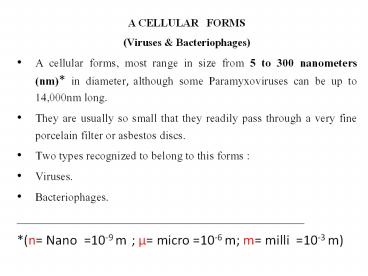A CELLULAR FORMS (Viruses - PowerPoint PPT Presentation
Title:
A CELLULAR FORMS (Viruses
Description:
A CELLULAR FORMS (Viruses & Bacteriophages) A cellular forms, most range in size from 5 to 300 nanometers (nm)* in diameter, although some Paramyxoviruses can be up ... – PowerPoint PPT presentation
Number of Views:123
Avg rating:3.0/5.0
Title: A CELLULAR FORMS (Viruses
1
A CELLULAR FORMS(Viruses Bacteriophages)
- A cellular forms, most range in size from 5 to
300 nanometers (nm) in diameter, although some
Paramyxoviruses can be up to 14,000nm long. - They are usually so small that they readily pass
through a very fine porcelain filter or asbestos
discs. - Two types recognized to belong to this forms
- Viruses.
- Bacteriophages.
- __________________________________________________
- (n Nano 10-9 m µ micro 10-6 m m milli
10-3 m)
2
What is a virus?
- Viruses may be defined as acellular organisms
whose genomes consist of nucleic acid, and which
obligately replicate inside host cells using host
metabolic machinery and ribosomes to form a pool
of components which assemble into particles
called VIRIONS, which serve to protect the genome
and to transfer it to other cells.
3
- Viruses are obligate intracellular parasitic
microorganisms which are smaller than bacteria
and so could pass through bacterial filters. - They form a group which live on other living
systems such as humans, animals , insects ,
plants , bacteria and fishes . - The largest ones coming somewhat closer to the
smallest bacterium . - These viruses are highly selective and specific
to their hosts. - They are known to be responsible for several
diseases of man, animal, plant, etc.
4
Viruses
- Viruses are infectious agents with both living
and nonliving characteristics. - 1. Living characteristics of viruses
- a. They reproduce at a fantastic rate, but only
in living host cells. - b. They can mutate.
- 2. Nonliving characteristics of viruses
- a. They are acellular, that is, they contain no
cytoplasm or cellular organelles. - b. They carry out no metabolism on their own and
must replicate using the host cell's metabolic
machinery. In other words, viruses don't grow and
divide. Instead, new viral components are
synthesized and assembled within the infected
host cell. - c. The vast majority of viruses possess either
DNA or RNA but not both.
5
Nature of viruses
- Viruses cannot be grown on artificial media.
- They can only grow in living organisms or tissue
cells which are kept alive in suitable medium.
6
Morphology of Virus
- According to the shape, viruses can be classified
into the following groups - Spherical. With a size ranging from 18 to 150 m µ
This includes , as example , the viruses of
influenza. - Rod-shaped. They are 300 mµ in length and 15 mµ
in width. It is represented by the tobacco mosaic
virus. - Cuboid. With a size ranging from 210 to 305 mµ.
This form is found in cowpox and canary pox
viruses (Fig. 26 C ) . - Spermatozoid-shaped. The size varies from 10 to
225 mµ. This form is characteristic of phages.
7
Composition of viruses
- Viruses have the same general chemical
characteristics , being composed of molecules of
nucleic acid ( either RNA or DNA ) and protein. - They have the capacity of existing either alone
or aggregated in the form of crystals which
contain millions or even billions of molecules. - The virus unit or particle is called a virion.
- The virion structure is similar in different
virions from the general point of view . - This virion is composed of folded strands of
nucleic acid inside a coat made of regularly
arranged protein subunits (capsoids). - The simple types of viruses are only
nucleoproteins, while the most complex types (as
cowpox) contain in addition other compounds such
as lipids, carbohydrates and sometimes traces of
metals and vitamin-like substances. - Viruses contain either DNA or RNA , but both
never occur together in one virus. - The plant viruses contain only RNA while the
animal viruses may contain either RNA or DNA . - Bacterial viruses or phages usually contain DNA.
Compassion of virus
8
Mechanism of virus infection ( Reproduction )
- 1. Adsorption of the virus The infective virus
has to be bound at first to certain receptors on
the outer surface of the host cell. - 2. Penetration There are two views concerning
this phase - The whole virus consisting of nucleic acid and
protein penetrates into the cell , although the
protein part has no role on the further steps of
infection. - Only the nucleic acid part penetrates into the
cell, i.e. the virus has to get rid of its
protein coat before penetration - 3. Blocking of cell information The
introduction of viral nucleic acid in the host
cell inhibits and blocks the original genetic
information in the DNA of the chromosomes, and
the nucleus has no longer any control on the cell
activity. - 4. Synthesis of virus components. the viral
nucleic acid forces the cell to replicate the
virus constituents ( nucleic acid and protein ) .
This new synthesis is completed in few hours. - 5. Excretion of the virus In some virus
diseases the excretion or release of the virus is
accompanied by the disintegration of the cell,
while in others both the nucleus and cytoplasm
remain contact.
9
life cycle of virus































